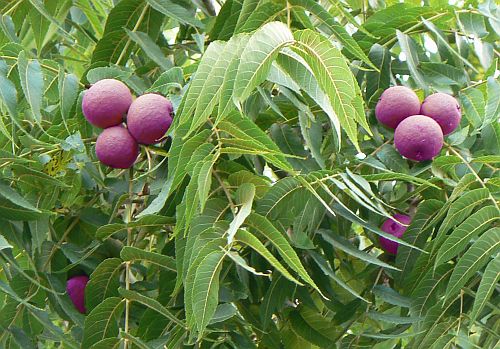Mikmik Tree
From Mizahar Lore
One of the many native trees of Falyndar, the Mikmik tree drops edible fruits that have a wide variety of applications.
Overview
The dense jungle vegetation of Falyndar is bountiful in its harvests, producing many different types of plants that cannot be found, or, indeed, grow pretty much anywhere beyond the sweltering jungle. The Mikmik tree is one of them. Found throughout Falyndar, it is most common in the center areas in thick groves. The Mikmik is also often protected by whipvine. The Mikmik has a thick, heavy trunk that tends to gnarl and get knobby as it ages, often making a great home for numerous insects and grubs. The trees grow to be about 30 feet at their top branches, and the upper half is thick boughs with great, spiny green leaves. It's not unusual to find a Bloodbill has made its nest in one of them, and battles for such nesting places can be loud and raucous. Anyone trying to pick those fruits had better be prepared to scare off the Bloodbill that will likely take offense to their taking its treats.
The Mikmik gets its name from the sounds made by Bloodbills that love to feast on them. The fruits grow year round, taking about two seasons from bud to maturity. The fruit's growth stage is visible at a glance. Underripe mikmik fruit is small and green, and the flesh is as hard as a rock. They make useful ammunition for slings and slingshots if nothing else is available, and when wielded with enough force, can drop lighter prey in its tracks, and cause some very serious impact; stunning them with a well-connected shot if not killing them outright. The darker the green, the younger the fruit. As the fruit ages, it grows to be a round, reddish-purple, heavy fruit of perhaps 4" in diameter. It begins to split down the center, the toughened skin slowly peeling. When the cleft reaches the pit inside, the fruit is perfectly ready for eating... according to the Myrians and the Bloodbills (which care only for the pit and happily discard the fruit to the numerous mammals below). The pit itself is covered with a thin, webbed lacing with the texture of smooth rubber. If the fruit is allowed to continue growing past its ripe point, they will continue to darken and bruise and eventually fall off of the tree.
Usage
The Myrians have developed many uses for the Mikmik. If you need to, the underripe fruit makes a great weapon, and it is edible in a pinch, though it is mildly toxic to non-Myrians and will generally cause cramps and stomach ache lasting about two to three hours. The ripened fruit is edible, while being quite tart, and can be preserved in clay pots for later usage in sauces, chutneys, relishes, and salsas, as well as on its own or with the maza meal tortillas. It is often sweetened with sugarcane, or a combination of sweeter fruits and vegetables. It can also be sliced or cut into chunks, cooked and crystallized with sugarcane in the earthen hearths, and let dry as a bit of sweets that are often brought out on special occasions. The tskannas are also quite fond of them. The bright skin, in addition to being a useful dye for skin, hair, and clothing can be used to help draw out infection from insect-inflicted wounds.
But perhaps the most desired part of all of the fruit is the nut in the inside. This nut, only the size of a walnut, is an intensely aromatic spice that is quite sweet, almost similar to nutmeg, but much more intense. It is one of the most popular spices of Taloba, and can be found in a wide variety of dishes. It can be used fresh, which it often is in beverages. It can be blended and boiled into juice with the flesh of the fruit to make a refreshing, tangy drink that the Myrians call pajado. Otherwise, it is usually smoked or dried before being used in other applications. If the nuts are smoked rather than dried, the flavour changes considerably - losing some of their sweetness and becoming earthy and musky rather than sweet. After drying or smoking, it is usually served grated into or on top of plants or meat to impart their desired flavours.
The rubbery webbing around the nut is also used, though it is usually dried out in woven baskets. When dried, it loses the rubbery texture and begins to feel more like a sheet of linen paper. It is then crushed with a mortar and pestle into either coarse or fine flakes, and can be used as a light-flavoured, savory seasoning or into medicines to help with digestion. It can also been packed into poultices and used to treat burns.
